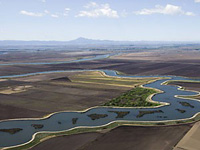It Never Rains in California...
 Globe-Net - They came by the thousands, united in one common goal - to protest reduced water deliveries to one of the world’s major agricultural regions. Growers, farm workers, community leaders, politicians and environmental activists participated in a four-day, 50-mile “March for Water” in California’s Central Valley last week to protect an industry vital to central and southern California.
Globe-Net - They came by the thousands, united in one common goal - to protest reduced water deliveries to one of the world’s major agricultural regions. Growers, farm workers, community leaders, politicians and environmental activists participated in a four-day, 50-mile “March for Water” in California’s Central Valley last week to protect an industry vital to central and southern California. One clear message emerged from the rally; this fight, which has heightened urban-rural tensions that could help those seeking to unseat Governor Arnold Schwarzenegger, is far from over.
While the farm workers descended on the San Luis Reservoir to conclude their march, millions of Californians were told they would face mandatory water restrictions for the first time in 18 years. The Metropolitan Water District (MWD) of Southern California announced cutbacks to local water agencies, citing the drought and the tighter environmental restrictions in northern California’s Sacramento-San Joaquin Delta, which supplies much of the water to the south.
“Up to 19 million southern Californians this summer will feel the impact of a new water reality that has been in the making for years, if not decades,” said MWD board chairman Timothy Brick in a statement.
It will not be an easy problem to overcome. California is in the midst of its third dry year and in February Governor Schwarzenegger declared a statewide water emergency requiring reduced allocations of water throughout the state.
Central Valley farm revenue loss is estimated to range between $325 million and $477 million, according to the California Drought Report. Total income losses to those directly involved in crop production and to those in business related to crop production is estimated to range between $440 and $644 million.
The result of the sustained drought, according to the report, will be an estimated loss of 16,200 to 23,700 full-time equivalent jobs. Last week U.S. Secretary of the Interior Ken Salazar and Governor Schwarzenegger announced $260 million in economic stimulus projects from the American Recovery and Reinvestment Act to help California address its water supply challenges and drought conditions on Wednesday.
“Too little too late”, according to Central Valley farmer Stephen Patricio, who described the stimulus pledge as “a touchy-feely, warm-and-fuzzy, feel good, pork project without any true benefit.”
Patricio, who also is chairman of the board of directors for the Western Growers Association, has laid off hundreds of workers on his 2,000-acre cantaloupe farm near Firebaugh in the past few years and watched dozens of his neighbouring farmer friends go belly up.
The water supply cutbacks for urban consumers are not nearly equal to what’s happening in farmer’s fields. Many growers don’t expect to get any federal water deliveries at all. “The overall water supply situation has not improved enough to make up for the two previous dry years and low reservoir conditions,” says Department of Water Resources Director Lester Snow. “Water storage is about five million acre feet below average,” he added.
If there is a bright side to this situation it’s the rise in various water conservation projects that are springing up across California. Tim Pope, president of the American Rainwater Catchment Systems Association (ARCSA), sees a growing demand for information about harvesting rainwater.
“Rain harvesting is growing tremendously in the United States, especially in California,” said Pope. “California seems to wait for a catastrophe (drought) before it goes after a cause like collecting rainwater.” Rain harvesting systems are being planned in several cities across the state. But much more will be required to improve local, district and regional water distribution systems.
In addition to raising the price of water and placing restrictions on its use, other incentives are being implemented, such as rebates for people who purchase energy efficient appliances and assistance to help people plant drought-resistant landscapes.
Metropolitan Water District Jeffrey Kightlinger in a press statement said the drought has “required us to purchase expensive replacement supplies, accelerate funding of alternative water supply programs and finance Delta sustainability projects, including the protection of endangered species,” he said.
“We’re beginning to get to the real cost of water,” says Colin Sabol, vice president of marketing for ITT Corporation, the world’s largest provider of pumps and water equipment. He notes that US consumers pay on average only one-third of what Germany pays for its water.
Massive investments will also be required to upgrade the state’s water distribution system to meet the demands of a population nearing 38 million people. “… California’s severe drought conditions are only a preview of what is likely to come because of our changing climate,” said Governor Schwarzenegger commenting on the release earlier this month of the Climate Action Team (CAT) Draft Biennial Report.
“California’s drought has already had devastating effects on our people, our communities, our economy, our agriculture and our environment. We have been aggressively working to not only fight climate change but adapt to it, which is why we must upgrade California’s water infrastructure to ensure a clean and reliable water supply.
For more information on the California drought you can visit the DWR website
You can return to the main Market News page, or press the Back button on your browser.

